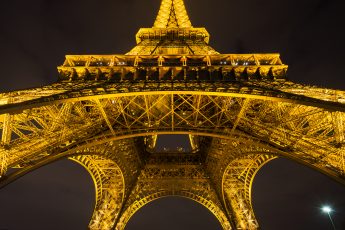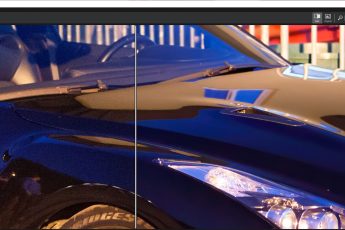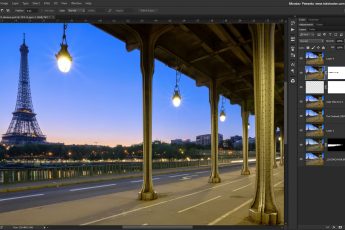Today I’m starting a new series on the blog, Photography Basics. In this series I will go through the basics of photography, especially meant for those of you, who are just beginning. If you are an advanced or expert photographer, you will probably find this boring :) But if you are just a beginner, this might be exactly what you need. I will try to explain things as simple as I know, to make them easier. So lets start.
Part 1 – Exposure
Photography is about light. When you are capturing a photo, you let light hit the sensor (or film) in you camera. So the most important thing that you have to set up on your camera, is the amount of light it lets in when you take a photo. You can of course let the camera do it all for you, but then you loose control over the look of your photo.
The amount of light that gets onto the sensor, is determined by three parameters. Those are:
- aperture – how big is the opening through which the light gets into the camera
- shutter speed – how long is the opening that let’s the light in, open
- ISO – how sensitive the sensor (film) is to the light.
There three parameters determine if you get a properly exposed photo, and few more things about the photo (which we will take a look shortly). Knowing how to set them up and when to use what values, is probably the most important thing you need to know when trying to take a photo.
Exposure triangle
Aperture, Shutter speed and ISO are usually shown forming a triangle. The reason for this is, that they are all connected. When one of them is changed, one or both from the other have to be compensated, to keep a proper exposure.
 For instance, if you change the aperture, making the opening smaller, you either have to use longer time, or bigger sensor sensitivity (ISO), or both, to compensate. If you choose smaller sensitivity (ISO), you have to have a bigger opening, longer time or both, to get a proper exposure. And so on.
For instance, if you change the aperture, making the opening smaller, you either have to use longer time, or bigger sensor sensitivity (ISO), or both, to compensate. If you choose smaller sensitivity (ISO), you have to have a bigger opening, longer time or both, to get a proper exposure. And so on.
Aperture
Aperture, determines how big is the opening in the lens, that lets in the light. A very important thing here to remember is, that bigger apertures (bigger opening) are noted with small numbers (starts at 1 and goes up from there) and small apertures are noted with higher numbers. So if you change the aperture for instance from f2.8 to f16, that means you made it smaller. There main effects of different apertures are:
- the bigger the aperture, the shorter shutter time and lower ISO you need to get a proper exposure
 the bigger the aperture, the less DOF (depth of field – the distance between the closes object in focus to the furthers object in focus) you get, and most of the photo will be out of focus (object in focus are shown as sharp on the final photo, out of focus are blurry)
the bigger the aperture, the less DOF (depth of field – the distance between the closes object in focus to the furthers object in focus) you get, and most of the photo will be out of focus (object in focus are shown as sharp on the final photo, out of focus are blurry)- the smaller the aperture, the more of a star effect you will get on light points.This is an effect, where light points are captured as small stars, with rays going from them in all directions (see example to the right)
- aperture also influences sharpness, with each lens having a sweet spot, an aperture where it is sharpest. The difference here is not that huge, and in the most of the time you can just ignore this.
So when you are choosing the aperture, you have to think about, what you want to archive and what you require. You choose a bigger aperture, when you are shooting from hand, so making the exposure time shorter, or when you want to have a shallow DOF, for instance in portraits. You choose a smaller aperture, when you want a longer exposure time, or when you want a big DOF to have everything in focus.
Here are two examples for you, one with shallow DOF (big aperture used) and one with huge DOF (small aperture used)
Shutter speed
Shutter speed determines, how long the lens opening is open and allows light to hit the sensor. Most cameras allow this to be set from 1/8000 of a second, up to 30s (the times may wary between cameras). There is a way to go over 30s, but that will be covered in camera modes. The main effects of different shutter speeds are:
- shorter shutter speed freezes motion. The longer the shutter speed is, the more blurred the moving objects are, until the completely disappear by very long shutter speeds.
- faster shutter speeds are much better for handheld photography, as the shorter the required time is, the better chance of being able to hold the camera without moving it.
When choosing your shutter speed, usually you want to go for the shortest that you can. The exception is if you are trying to get a specific long exposure effect. In that case, the time you need varies. For instance getting a bit of softness info flowing water, you need few second, for making flowing water look almost like ice, you need 30s or more.
Here are another two examples. In one the short shutter speed froze the cars in place, in the other the long shutter speed blurred them out, and only light trails remained.
ISO
The last parameter is the sensitivity of the sensor (film). ISO starts at 100 (with few professional cameras being able to go lower) and goes up from there up to 100 thousands. This is more of a complimentary parameter, as normally, one changes it only when really needed. Mostly the goal is to just keep it at low as possible (at the camera default setting). The main effects of ISO are:
- the bigger the ISO, the shorter time and smaller aperture you can use, to archive a proper exposure
- the bigger the ISO, the more noise you will get in your photos. So having a lower ISO will result in much cleaner photos.
So the main reasons for using a higher ISO is, to get a shorter shutter speed. Either you are shooting in a dark place handheld, or you are trying to capture something that changes really fast. Going with a higher ISO is usually the last step in setting up a proper exposure, as except for artistic reasons, one prefers a cleaner photo result.
You should experiment with your camera, too see what highest ISO you can use, what is the biggest amount of noise you are willing to accept in your photos. Also note, a high ISO can result in the loss of detail, as the noise becomes more dominant than small detail.
Here are two examples for ISO. First one was taken handhold inside a church, where I had to use a high ISO of 1600. The second one is taken from a tripod, so I could use an ISO of 100 without problems.
So this covers the basics of exposure, and in the next parts we will take a look at camera modes and when to choose which mode, RAW vs JPEG, white balance, focusing and much more :).














Leave a Comment